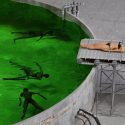Mars didn’t always look like this. It may have once been covered in oceans. But what if we brought all the Martian water back and transformed the red planet into one that’s half blue? What would Mars look like if it was 50% land and 50% water? Where would we even find enough water to fill Martian oceans? And why might we have no choice but to nuke the red planet?
Long ago, Mars could have been covered by a massive ocean. And there may have been rivers, streams and lakes spreading out across the planet too. It might be that billions of years ago, Earth and Mars had similar climates. Except the Martian ocean covered only 20% of the planet compared to Earth’s 71%, and the surface temperature was a bit cooler.
All of that thanks to an atmosphere that didn’t stick around long enough. Four billion years ago, Mars lost its protective magnetic field, and the solar winds started to carry all of its atmosphere off into space. A few hundred million years later, Mars changed from a warm, wet world to what we know it as today. Cold and dry. Only 18% of its ocean remains, trapped in frozen polar ice caps.
So if you wanted to turn Mars into half land, half ocean kind of planet, you’d need to add a whole lot of water. Unlike Mars, most of Earth is covered with oceans. So what do you say we donate some of that water to our red neighbor? Let me tell you, that’s a very bad idea. To make Martian oceans as deep as Earth’s, you’d need to ship out about 20% of our own ocean water.
And this would suck for our marine life. Leave the Earth’s oceans where they belong. Besides, there are a few other places in the Solar System where you could find water. Like Saturn’s moon Enceladus and Jupiter’s moon Europa. They might have twice as much water as Earth. But to transport some of that precious H20, you’d need to move massive ice blocks through space.
This would be difficult to pull off. You’d need rockets capable of transporting huge amounts of weight. And you’d need money. A lot of it. The price could be as high as $1,500 per kilo (2.2 lb). Considering how much water you’d require, the final price tag for this operation would be well into the trillions.
Expensive, I know. But there might be another way of bringing Martian water back. You’ll love this one, because it involves nukes. You heard me right. You’re about to nuke the red planet. And yes, this would give it some water. How? Well, all that energy would release Martian frozen carbon dioxide. This would cause temperatures to climb and thaw out the poles.
It would be like causing controlled climate change. Only you’d need to detonate around 3,500 nuclear bombs every day. This would mean daily shipping twice as many bombs as the U.S. currently has in its entire arsenal. That’s an enormous amount of radioactive material to release. And it wouldn’t exactly make Mars habitable.
You’d still need a lot more water to cover half the planet in oceans. OK, it seems like nuking everything in sight isn’t the best idea. Maybe you should take a little planetary history lesson instead. About four billion years ago during the Late Bombardment Period, a non-stop barrage of asteroids collided with Mars.
This created enough water to eventually make an ocean 300 m (1,000 ft) deep. All you’d need to do is recreate this event today. You’d have to redirect at least a million comets and meteors so they’d end up on a collision course with Mars. As the comets crashed into Mars, they’d burn up and release water vapor.
Repeat until you get enough water to cover half of the red planet. But where would this water go? Looking at Mars’ topography, you’d find that all this new water would settle mostly above its equator. Mars would have new landmasses that would look like continents. There would even be mountains sticking up on some parts of the planet.
Olympus Mons, the tallest volcano in the Solar System, would now tower high out of Mars’ new northern ocean. But just because you were able to bring enough water to cover half the planet, that wouldn’t mean it would last. Because of Mars’ low atmospheric pressure, all this water would easily boil away. Wait, how would it boil away if water’s boiling point is 100 °C (212 °F)?
Well, that’s the boiling point on Earth. On Mars, the water would start to boil at 0 °C (32 °F). Ugh, that’s frustrating, especially after all the work you put into bringing so much water to Mars. You’d have to hope that all this water vapor would work as a greenhouse gas. If it could trap enough heat in the Martian atmosphere, and turn Mars into a lush terraformed world. Maybe then you’d be lucky enough to be the only Earthling to ever go for a swim on another planet.
Sources
- “Chilly, Damp Mars May Have Hosted An Ancient Ocean”. Charles Q. Choi. 2022. space.com.
- “How Mars lost its oceans”. 2022. sciencedaily.com.
- “How Did Mars Lose Its Atmosphere? | BBC Science Focus Magazine”. Dr Alastair Gunn. 2023. sciencefocus.com.
- “How Deep Is The Ocean?”. 2023. oceanservice.noaa.gov.
- “In Depth | Mars – NASA Solar System Exploration”. 2023. solarsystem.nasa.gov.



























